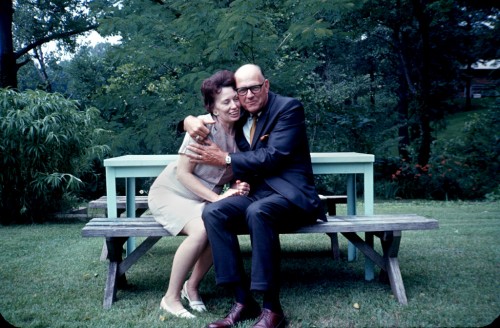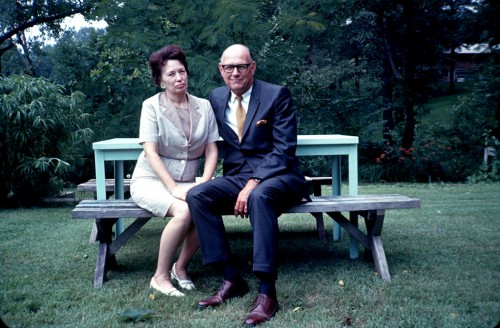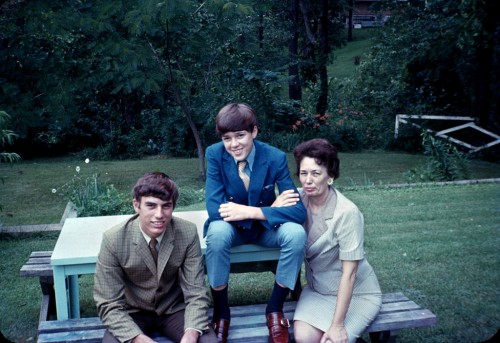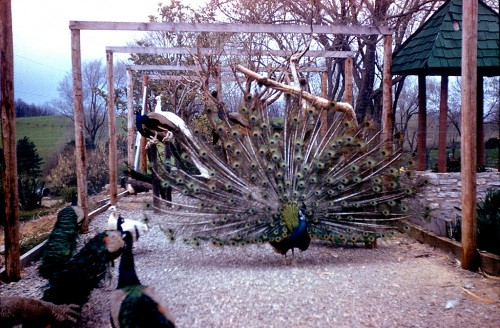Wife Lila was trying to make some space in the guest room closet when she asked, “Did you know there’s a big plastic box of slides and film in here?”
The answer was, “No, but I hope it’s got some stuff in it that I’ve been looking for.”
Unfortunately, it doesn’t appear to contain photos of the old St. Francis Hospital before it was torn down or two slide trays from my trip to Philmont Scout Ranch.
Smiles and moisture
 It DID have a treasure trove of color slides and black and white photos from 1961, when I got my first 35mm camera, an Argus Autronic 35. I used it to shoot photos of my Trinity Lutheran School classmates, scenics and some family photos that bring a smile to my face and, in a few cases, some moisture to my eyes. (Click on any photo to make it larger.)
It DID have a treasure trove of color slides and black and white photos from 1961, when I got my first 35mm camera, an Argus Autronic 35. I used it to shoot photos of my Trinity Lutheran School classmates, scenics and some family photos that bring a smile to my face and, in a few cases, some moisture to my eyes. (Click on any photo to make it larger.)
I started to make this a piece about the peacocks at Memorial Park Cemetery – even had the photos uploaded and the headline written, but I kinda painted myself into a literary corner and decided to put that photo of Mother and Dad in to get me out of it.
I don’t remember taking it, probably because the moment didn’t mean as much to me then as it does now. I often say that some days you make pictures; other days you make memories. This was one of those cases when I’m glad I made a photograph that lets me fill in a memory that I DIDN’T make at the time.
One day you’ll understand
 I think Dad knew what had happened. I can read in his expression, “Kid, one of these days, you’ll understand.”
I think Dad knew what had happened. I can read in his expression, “Kid, one of these days, you’ll understand.”
Composition needed work
 We had a pretty back yard, but I don’t think it was nice enough to explain why I cropped the picture the way I did to show more yard than family. That’s Brother David on the left and Mark in the middle.
We had a pretty back yard, but I don’t think it was nice enough to explain why I cropped the picture the way I did to show more yard than family. That’s Brother David on the left and Mark in the middle.
Chekov’s Gun and the peacocks
 “Checkov’s Gun” is a literary rule that says “If in the first act you have hung a pistol on the wall, then in the following one it should be fired.” Since I brought up peacocks, I guess I better produce them. This was one of several peacock pictures from 1961. You may see others later.
“Checkov’s Gun” is a literary rule that says “If in the first act you have hung a pistol on the wall, then in the following one it should be fired.” Since I brought up peacocks, I guess I better produce them. This was one of several peacock pictures from 1961. You may see others later.
I wrote about the history of Memorial Park and the Tower of Memories in the fall of 2010.

Ken, these are cool family pics. Question somewhat off the subject. What is the best way to convert slides to digital? I have a scanner, but not sure what is the best way to do this. Got any suggestions? (I have a bunch of slides from the 49 Cape tornado I want to convert). Thanks. Don.
If you didn’t have a scanner, here’s one that I recommend.
I’ve played with it and was impressed with how well it dealt with both negatives and slides. The film carrier is a little flimsy, but the slide holder is easy to deal with. The nice thing is that it will scan the whole holder of film automatically once it’s loaded.
No scanner is fast and easy, unfortunately. Even my $2,000 Nikon Super Coolscan 8000 seems to take forever.
Getting the film digitized is only half of the battle, generally the easiest part. If you’re scanning old film with fading and lots of dust, scratches and flaws, it’s going to take a lot of time and a lot of practice. Here’s where I show how you can save a “bad” photo.
There’s another before-and-after photo at the bottom of this page.
I use a program called VueScan to interface with my scanners. The advantage is that you don’t have to go searching around for drivers for old hardware. The program will work with just about anything and is updated almost weekly. It also means that I have the same interface for both my flatbed and my film scanners.
I use Adobe Photoshop for my editing because I’m dealing with still photos, videos and audio files. The learning curve is steep and the software is expensive. (I saved a bundle by signing up for a course at the local community college. By being a student (for about $50), I was able to buy the software for about $400 instead of $2K+.
I’ve found the editing tools in Google’s Picasa to be easy to use and – best part – FREE. If you’re not a pro, go for that.
Don, if this is a one-time scanning, the best way to do it is to take them to your local photo shop.
There is a place in town that will do it for 25 cents a slide. A hundred slides is $25 and they will give you the scans on a CD. The quality isn’t as good as if you carefully scanned them all yourself but they are good enough.
Cheers,
Matt
For those without the means to purchase Photoshop, GIMP is an open-source alternative that does many things very well. There’s still a learning curve associated, but you can play with with layers, filters, and some advanced techniques for no cost.
Of course, my favorite line (and the heart of this blog post) is “This was one of those cases when I’m glad I made a photograph that lets me fill in a memory that I DIDN’T make at the time.”
I like how it bridges the two types of days you talk about, which is a phrase of yours I really admire and that I’ve taken to saying and thinking.
Thank you, Miz Anne. I take that as quite a compliment.
Anne is one of my regular riding partners, a refugee from the newspaper business and a writer who can sling words with the best of ’em. She almost done with a book, “Kiss and Tell.” I talk more about her book and her unfortunate love connection on my bike blog.
Kenny,
How marvelous it must be to find all these long-ago photographs and to view them almost as if seeing them for the first time! I envy you this experience…filling in a memory that you didn’t make at the time. I so enjoy taking this journey with you!! Often viewing your photos is like seeing something for the first time even though I saw the same thing countless times in my youth. I expect sometimes youth gets in the way of letting one see things completely. As always, thanks for letting us be a part of your memories.
Today I found an Argus Autronic I at the thrift store, and I’ve been doing some browsing as to what kind of camera it is and what kind of picture it takes. Thanks for sharing yours!
It had a roll of film in it which I accidentally exposed. I dropped it off at Walgreens and hopefully something will come out of it… The film roll itself was quite old. I don’t know how long film is ‘good’ for, unexposed or exposed, but I still hold out hope. I’m not a camera person, but it sounds fun using this old camera.
How long film is “good for” depends a lot on how it was stored. I’ve processed film – including some that was highly heat sensitive – as much as 10 years after it was exposed. If you closed the camera back right after you opened it, you will lose the film that was exposed to the light, but stuff inside the film can and that was on the takeup reel may be OK.
It’s always worth a try.
Your dad was a sharp dresser! A person can tell from these photos that you came from ‘good people’. Nice to have great memories.
Dad was part of the generation of men who still wore hats. Check him out here.